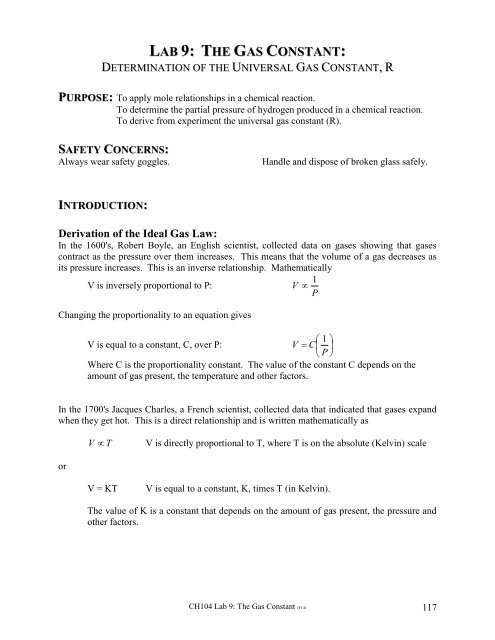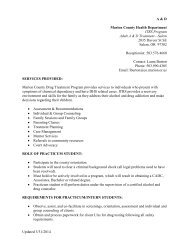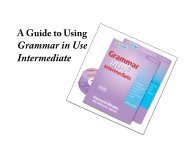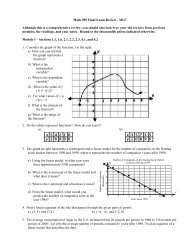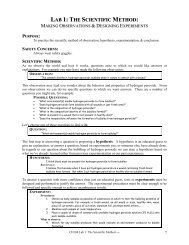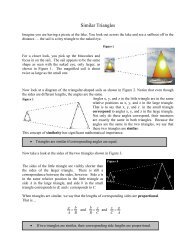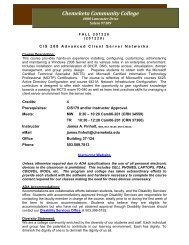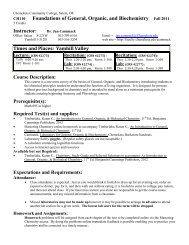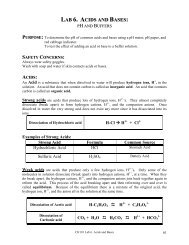9 Determination of Gas Constant - Faculty.chemeketa.edu
9 Determination of Gas Constant - Faculty.chemeketa.edu
9 Determination of Gas Constant - Faculty.chemeketa.edu
Create successful ePaper yourself
Turn your PDF publications into a flip-book with our unique Google optimized e-Paper software.
In everyday experiences, whether working in industry, medicine, a science laboratory, or even athome, we find that all three properties <strong>of</strong> gases (temperature, volume, pressure) determine howwe are going to handle gases. So, it is more informative to consider how the volume <strong>of</strong> a gaswill change with both a change in pressure and a change in temperature. The combined ideas <strong>of</strong>Boyle and Charles can be expressed mathematically asTV PorTV SPV is directly proportional to T (Kelvin) and inversely proportional to P.V is equal to a constant S, times T divided by P.The constant, S, depends on how much gas is present, replacing both constants C and K.To make the combination <strong>of</strong> Boyle’s and Charles’ gas laws even more general and moreconvenient to use, we can consider the results <strong>of</strong> Amadeo Avogadro, namely that equal volumes<strong>of</strong> gases contain equal amounts <strong>of</strong> gas molecules at the same temperature and pressure. Thevolume is directly proportional to the number <strong>of</strong> molecules, or the number <strong>of</strong> moles (n) <strong>of</strong> the gasV nor V = QnWhere Q is a constant that depends on both the T and P <strong>of</strong> the gas.Incorporating Avogadro's law into the combined gas law,TV nPorTV RnPor PV = nRTThe constant R replaces the previously used C, K, S, and Q and combines them into oneproportionality constant called the Universal <strong>Gas</strong> Law constant. It is independent <strong>of</strong> theamount <strong>of</strong> gas present and depends only on what units are used for V, P, and T. Onecommon value for R is 0.0821 L atm mol -1 K -1 .In this experiment you will use PV = nRT (the Ideal <strong>Gas</strong> Law) to experimentally determine theUniversal gas law constant, R. Report your value for the Universal <strong>Gas</strong> Law constant based on ameasured volume <strong>of</strong> hydrogen gas produced by the action <strong>of</strong> hydrochloric acid on a knownamount <strong>of</strong> aluminum foil. The unbalanced chemical reaction is____Al(s) + ____HCl(aq) ___H 2 (g) + ____AlCl 3 (aq)118CH104 Lab 9: The <strong>Gas</strong> <strong>Constant</strong> (F14)
PROCEDURES:ACTIONS:I. PRODUCTION OF H 2 GAS:1. Obtain a plastic syringe with tubing and stopper andput together the apparatus as shown. 1 Push theplunger on the syringe all the way into the syringe.2. Obtain a piece <strong>of</strong> aluminum about ½ inch by 1 inchand clean it with steel wool to remove any oxidelayer on the Al that will interfere with the reaction.This amount <strong>of</strong> foil is enough for two trials so cut itin half. Wipe each piece with a clean towel ortissue. 23. Using tongs, weigh a piece <strong>of</strong> the aluminum on theanalytical balance to the nearest tenth <strong>of</strong> a mg.(0.0001 g). Use between 0.011 and 0.015g. 3Record the mass used on the report sheet. (Box A)4. Take the stopper out <strong>of</strong> the 250 mL flask and put in10 mL <strong>of</strong> 3 M HCl.5. Observe and memorize the shape and the feel <strong>of</strong>the pressure within the finger bulb.6. Drop the weighed piece <strong>of</strong> Aluminum into the acidsolution and quickly insert the stopper tightly. 4 Thefinger bulb will inflate slightly, so bring the syringeplunger out a little until the bulb is the same shapeas it was earlier. 57. Once the flask is at atmospheric pressure read theinitial volume 6 on the closed syringe with anaccuracy <strong>of</strong> 0.2 mL. Record this volume. (Box D) 78. Make sure the flask is upright and that the foil iscompletely covered with acid. As the reactionproceeds, 8 the pressure in the flask rises and thefinger bulb will inflate. Every so <strong>of</strong>ten pull out thesyringe to bring the bulb back to its original shapeto release the pressure. 5NOTES:1 <strong>Gas</strong> pressure collection apparatus. Thefinger bulb acts as a simple pressuregauge. Check to see that the stopper fitssnugly into your 250 mL Erlenmeyer flaskand that the apparatus does not leak.2 Avoid touching the foil with your fingersfrom now on.3 The quantity <strong>of</strong> Al should be in this massrange. You must know exactly how muchmass you have so your future calculationswill be correct.4The aluminum reacts with thehydrochloric acid according to thefollowing equation:2Al (s) + 6HCl (aq) 2AlCl 3(aq) + 3H 2(g)5 When the syringe is adjusted to maintainthe original bulb shape then the flask isback to atmospheric pressure.6 Typically between 1 -2 mL.7 As the reaction is quite slow (it takesabout 5 minutes to complete) evolution <strong>of</strong>hydrogen gas won't begin immediately, soyou have a few seconds to read the initialvolume.8 You can expect 15-20 mL <strong>of</strong> hydrogen tobe produced. The reaction is completewhen all the metal foil has reacted and thesolution has cleared.9. After the reaction has stopped, wait 5 minutes forthe system to equilibrate and cool.10. Once the reaction mixture has cooled, adjust thesyringe plunger in or out to get the finger bulb backto its original degree <strong>of</strong> inflation. Then read andrecord the final volume to within 0.2 mL. (Box E)CH104 Lab 9: The <strong>Gas</strong> <strong>Constant</strong> (F14) 119
Spheres <strong>of</strong> Influence | Nanosilver: Weighing the Risks and Benefitsclothing to slow the spread <strong>of</strong> MSRA andother bacterial infections associated withclose-contact sports. 5Rosalind Volpe, executive director<strong>of</strong> the Silver Nanotechnology WorkingGroup, says nanosilver also deservesa place in common household goods.A paper by the working group explains,“Nanosilver antimicrobial treatmentscan bring a number <strong>of</strong> functionalities toconsumer articles, including longer shelflife (e.g., cosmetics) giving more safety,less waste and ultimately lower prices forconsumers; plastics that are protectedagainst the degrading action <strong>of</strong> bacteria(e.g., discoloration); and textiles that areprotected against colonization <strong>of</strong> bacteriathat can lead to odors (e.g., sportsclothing), ultimately giving greater comfortand prolonged use. Additional benefitssuch as r<strong>edu</strong>ced washing frequency at lowertemperatures can give significant water andenergy savings.” 11How Much Is Too Much?But the expansion <strong>of</strong> nanosilver intonew applications may also contributeto unique risks. Looming large amongthem is the possibility that widespreaduse <strong>of</strong> nanosilver will contribute to silverresistance in bacteria, as has happenedwith other common antibiotics includingpenicillin, 16 tetra cycline, 17 and triclosan. 18Nanosilver impregnated into consumerproducts and coatings will slowly,through laundering, be abraded from itssubstrate material at varying volumes andover varying periods <strong>of</strong> time, dependingon concentrations in the material andthe strength with which it is bonded,says Bernd Nowack <strong>of</strong> the Swiss FederalLaboratories for Materials Science andTechnology. In consumer textiles, henotes, the industry standard is for theantimicrobial effect to persist over at least50 washes, although some research suggestsnanosilver can leach from certain productswithin the first few washes. 19Critics have questioned whether it’swise to dispatch such a powerful weaponWe’ve never actually found a pathogen we couldn’t kill.That’s why silver is being used all over. It’s an incrediblysafe, very broad-spectrum antimicrobial agent. It’s naturallyoccurring, and it’s just really effective.–Keith MoellerABL Medicalagainst bacteria in everyday contexts wherebacteria pose a relatively minor concern.“It’s one thing if we’re using a little bit<strong>of</strong> nanosilver in the shoes <strong>of</strong> diabetics,”says Jaydee Hanson, policy director forthe nonpr<strong>of</strong>it International Center forTechnology Assessment. “It’s another thingif you’re putting it in all underwear, allsocks, every bed, every bed sheet. It’s ahuge, exponential increase in the amount<strong>of</strong> nanosilver we’re putting into theenvironment.”Gregory Crocetti, a Melbournebasedmicrobiologist who has worked onFriends <strong>of</strong> the Earth Australia’s nanosilvercampaign, takes a stricter position.“Nanosilver should remain in a hospitalsetting only,” he says. “Those clinical useswill be diminished by completely hystericaland frivolous uses in homes. ... Nanosilverhas a high likelihood <strong>of</strong> promoting notjust silver resistance but also antibioticresistance because <strong>of</strong> the process <strong>of</strong>co-selection.” Co-selection occurs whenbacteria challenged with one antimicrobialfind a resistance gene to it by swappingDNA with bacteria that are resistant to adifferent antimicrobial. 20Environmental ConsiderationsUp to this point there has been limiteddocumentation <strong>of</strong> silver resistance. Thesefew cases largely have been isolated inin vitro studies rather than clinical orenvironmental settings. 21,22,23,24 However,one 1975 article reported that silverresistantSalmonella typhimurium had beenisolated from a Massachusetts burn ward; 25the molecular basis for the resistance wasproposed more than 20 years later. 26Some researchers and industry groupsargue that silver and microbes havecoexisted for billions <strong>of</strong> years and thatresistance would have become evident bynow if it were a viable threat. But Crocettipoints out that silver was not historicallyused in the context <strong>of</strong> the widespreadantibiotic resistance seen today.“It is widely thought that differenttypes <strong>of</strong> antimicrobial resistance geneshave not been assembled by bacteria intosuch large collections on mobile geneticelements, particularly plasmids, untilIt’s one thing if we’re using a little bit <strong>of</strong> nanosilver inthe shoes <strong>of</strong> diabetics. It’s another thing if you’re putting itin all underwear, all socks, every bed, every bed sheet.It’s a huge, exponential increase in the amount <strong>of</strong> nanosilverwe’re putting into the environment.–Jaydee HansonInternational Center for Technology Assessmentthe last few decades,” Crocetti says. “Itis important to note here that the siloperon—the major set <strong>of</strong> silver resistancegenes—is regularly found alongside thecassettes <strong>of</strong> antibiotic resistance genesEnvironmental Health Perspectives • volume 121 | number 7 | July 2013 A 223
LAB 9: THE GAS CONSTANTPRE LAB EXERCISES:NAME_____________DATE______________1. Write the balanced equation for the reaction <strong>of</strong> Aluminum metal with aqueous hydrochloric acid.2. A student took 0.0150 g Al and reacted it with HCl using the proc<strong>edu</strong>res in this laboratory exercise.The barometric pressure (P tot ) was 736.0 torr, the temperature was 22.0 o C, and the amount <strong>of</strong>hydrogen gas collected was 25.6 mL. Use this information to answer the following: Always keepappropriate number <strong>of</strong> significant figures.A. From the balanced equation determine how many moles (n) <strong>of</strong> hydrogen gas could be producedfrom the 0.0150 g Aluminum used. Show your calculations. Remember significant figures. Record answer inthe box provided.B. Convert the volume <strong>of</strong> hydrogen gas produced into liters (V).n =V =C. Convert the Celsius temperature <strong>of</strong> the experiment into Kelvin (T). (show calculations).D. If the total atmospheric pressure read by the barometer was 736.0 torr use the table <strong>of</strong> vaporpressures <strong>of</strong> water to determine the partial pressure (P) <strong>of</strong> hydrogen gas at 295K. (Remember thatP tot = P H2O + P H2 ) (Show calculations. Report P in torr and in atm).T =P =P =torratmE. Use PV = nRT to determine the value <strong>of</strong> R (in [L Atm]/[K mol]) using the above experimental data.(Show calculations including units).R exp =F. What is the accepted theoretical value <strong>of</strong> R? (Include units).R Theoretical =G. What is the % error? (Show calculations).% error =CH104 Lab 9: The <strong>Gas</strong> <strong>Constant</strong> (F14) 121
122CH104 Lab 9: The <strong>Gas</strong> <strong>Constant</strong> (F14)
LAB 9: THE GAS CONSTANTREPORT:NAME___________________PARTNER_________DATE___I. DATA & CALCULATIONS: Equation = _____________________________A. Mass Al Used (to 0.0001g)B. Moles Al usedC. Moles H 2 produced (n)(show calculations)Trial 1 Trial 2D. Initial volume, mLE. Final volume,F. Total volume gasproduced, mL (E-D)G. Total volume gasproduced, in LH. Temperature, o C(V)I. Temperature, K (T)J. Barometric Pressure, torr(P tot = P H2O + P H2 )K. Vapor Pressure <strong>of</strong> H 2 O,torr from Table (P H2O )L. Partial Pressure <strong>of</strong> dryH 2 , in torr (J-K))(P H2M. Partial Pressure <strong>of</strong> dryH 2 , in atmN. R = PVnT(show calculations)(P)O. % ErrorActual – Theoretical X 100Theoretical(show calculations)Explanation/ Analysis: Were your results expected? Explain.CH104 Lab 9: The <strong>Gas</strong> <strong>Constant</strong> (F14) 123
LAB 9: THE GAS CONSTANT:RELATED EXERCISES:NAME_____________1.___ What would be the effect on the calculated value <strong>of</strong> R if in your experiment the stopper were notquickly inserted after putting the Al into the acid?A. The calculated value <strong>of</strong> R would be too high.B. The calculated value <strong>of</strong> R would be too low.C. The speed at which the flask was stoppered makes no difference in the calculated value <strong>of</strong> R.2.___ What would be the effect on the calculated value <strong>of</strong> R if you had forgotten to account for thevapor pressure <strong>of</strong> water in the gas mixture <strong>of</strong> your experiment?A. The calculated value <strong>of</strong> R would be too high.B. The calculated value <strong>of</strong> R would be too low.C. The vapor pressure <strong>of</strong> water makes no difference in the calculated value <strong>of</strong> R.3. A student, Kim Estry, found a value <strong>of</strong> R = 0.0821 L atm / mol K using the proc<strong>edu</strong>res in thislaboratory exercise. The barometric pressure (P tot ) was 760.0 torr, the temperature (T) was 298 K,and the amount <strong>of</strong> gas collected (V) was 25.6 mL.A. What is the partial pressure (P H2 ) <strong>of</strong> the hydrogen obtained in Kim’s experiment? Showcalculations. Keep appropriate # <strong>of</strong> significant figures. Record answers in the boxes provided.P =P =torratmB. How many moles <strong>of</strong> hydrogen gas did Kim produce? Show calculations. Keep appropriate # <strong>of</strong>significant figures. Record answer in the box provided.n=C. Determine how many grams <strong>of</strong> Al that Kim started with? Show calculations. Keep appropriate # <strong>of</strong>significant figures. Record answer in the box provided.g Al =124CH104 Lab 9: The <strong>Gas</strong> <strong>Constant</strong> (F14)


